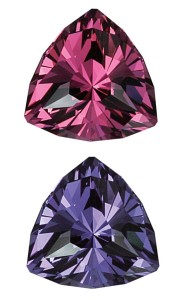Buy wise in the field

Not that long ago, local dealers weren’t always certain about what they had, but that has changed as these gem varieties gained in popularity, Dery says. “Now as they review their finds, they screen for any colour-shifting or colour-changing gems. They are aware of the premium placed on those particular stones.”
Being so far from testing labs can produce some surprises. Elser recalls a buying trip to Arusha, Tanzania, and a ‘mercy buy’ that was much more than she initially believed. “I bought a tourmaline from the man who ‘watched the door’ for me. It wasn’t a pretty stone, but I wanted to buy something from him as a thank you, beyond what he was being paid. A few weeks later, I selected it as the right shape to prototype a new design. When I finished, I discovered it was a green-yellow colour-change tourmaline. I’d never seen [this kind of stone] before, and I bought more on my last trip.”
The growing recognition of colour-change stones creates its own ripple effect at the source. “However, it’s also led to some opportunism at the [source], and it takes a savvy dealer to know what he or she is buying,” Dery reports. “Many locals try to pass off Malayan or other mixed-breed garnets as colour-change, but they only shift in the hue or saturation. These gems will not be accepted in the North American market as colour-changing stones, and are then discounted appropriately.”
Merchants take a shine to colour-change

Wholesalers find that offering quality colour-change goods that fit into luxury jewellery, as well as a bit of tutoring, help seal the deal. “Alexandrite is a hidden jewel among more common colourful stones,” says Daniel Kundakci, owner of European Design in Toronto. “Retailers showing off its unique colour-changing ability leave an indelible impression on their clients.”
The story matters, particularly when it comes to a stone’s colour-change percentage, and the different lights in which the customer can observe both colours. “Many individuals are intrigued with alexandrite and rely on the jeweller’s knowledge to gain more information and witness the beauty of this gem,” Kundakci observes.
Elser also sees the benefit to tutoring clients. “Customers absolutely need to be educated, and jewellers would do well to have different lights [on hand], and to encourage clients to look at all gems under various lighting conditions. Most gems will show some [shift], and seeing a gem truly change its personality is magical. Once people understand how to appreciate colour-change gems, they become an easy sale.”
Supply, pricing, and availability
Niveet Nagal, vice-president of Omi Gems, acquires top-notch alexandrite from Brazil’s Hematita mine. A significant alexandrite strike there in 1987 was the first major detection of gem-quality rough since its initial discovery in the Ural Mountains in the 1800s. “There is very little alexandrite being produced elsewhere in the world,” he explains. “The only other notable area is southern India. Substantial quantities of alexandrite come from this area, but most of it is relegated to mass production.”
Stones from different parts of the world can reflect their geographic origin, Nagal observes. “Alexandrite from India is a nice, bright green with grey or blue undertones. The majority of this material has insignificant colour-change and is generally lower quality than that from Brazil, which tends to have strong colour-change from bluish-green to reddish-purple, making it higher in price. Some Indian alexandrite can be gem-quality, but I’ve only seen a handful of that. Most collector-quality alexandrite available today comes from Brazil, although the region produces a wide range of alexandrite qualities.”
This stone’s popularity has affected supply, Nagal adds. “Unfortunately, even the Hematita mine is nearly depleted, adding to the rarity and demand for this rare colour-change stone.”





